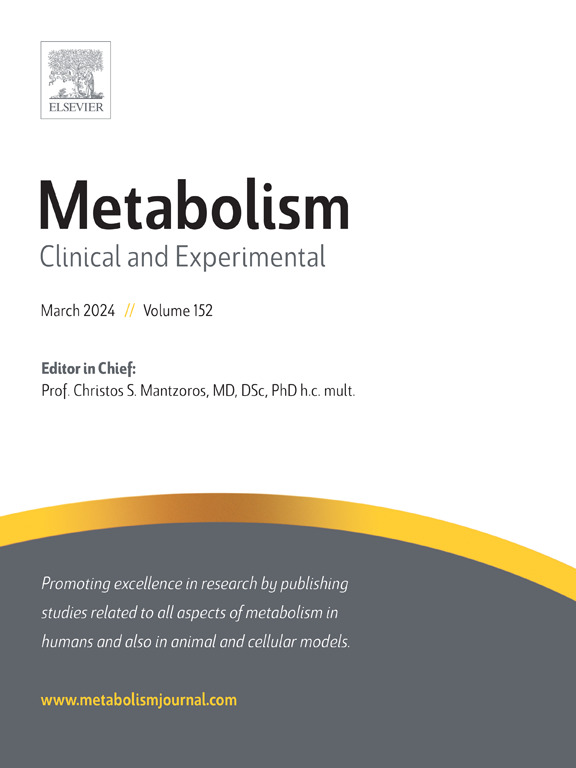C-C motif chemokines ligand 7 contributes to metabolic dysfunction-associated steatotic liver disease by enabling redox-sensitive induction of hypermethylated in cancer 1
IF 10.8
1区 医学
Q1 ENDOCRINOLOGY & METABOLISM
引用次数: 0
Abstract
Metabolic dysfunction-associated steatotic liver disease (MASLD) has become a global pandemic and the most critical implication for liver transplantation. In the present study, we investigated the role of C![]() C motif chemokine ligand 7 (CCL7) in MASLD pathogenesis focusing on mechanism and translational potential. We report that CCL7 blockade with a neutralization antibody attenuated MASLD in mice. RNA-seq performed in hepatocytes identified hypermethylated in cancer 1 (HIC1) as a novel target gene responsive to CCL7 treatment. CCL7 induced HIC1 expression was mediated by steroid receptor co-activator 1 (SRC-1) in a redox-sensitive manner. Mechanistically, enhanced ROS production by CCL7 activated protein kinase C theta (PKCθ), which in turn phosphorylated SRC-1 thereby enabling SRC-1 recruitment to the Hic1 promoter. Consistently SRC-1 depletion or HIC1 depletion ameliorated MASLD in mice. Further analysis revealed that SRC-1 activated Hic1 transcription in part by recruiting protein arginine methyltransferase 4 (PRMT4) in a redox-sensitive and phosphorylation-dependent manner. Importantly, pharmaceutical inhibition of PRMT4 activity with a small-molecule compound TP-064 mitigated MASLD in mice. Finally, relevance of the CCL7-SRC-1-PRMT4-HIC1 axis was confirmed in MASLD patients. In conclusion, our data uncover a previously unrecognized redox-sensitive mechanism underlying MASLD pathogenesis and present druggable targets for MASLD intervention.
C motif chemokine ligand 7 (CCL7) in MASLD pathogenesis focusing on mechanism and translational potential. We report that CCL7 blockade with a neutralization antibody attenuated MASLD in mice. RNA-seq performed in hepatocytes identified hypermethylated in cancer 1 (HIC1) as a novel target gene responsive to CCL7 treatment. CCL7 induced HIC1 expression was mediated by steroid receptor co-activator 1 (SRC-1) in a redox-sensitive manner. Mechanistically, enhanced ROS production by CCL7 activated protein kinase C theta (PKCθ), which in turn phosphorylated SRC-1 thereby enabling SRC-1 recruitment to the Hic1 promoter. Consistently SRC-1 depletion or HIC1 depletion ameliorated MASLD in mice. Further analysis revealed that SRC-1 activated Hic1 transcription in part by recruiting protein arginine methyltransferase 4 (PRMT4) in a redox-sensitive and phosphorylation-dependent manner. Importantly, pharmaceutical inhibition of PRMT4 activity with a small-molecule compound TP-064 mitigated MASLD in mice. Finally, relevance of the CCL7-SRC-1-PRMT4-HIC1 axis was confirmed in MASLD patients. In conclusion, our data uncover a previously unrecognized redox-sensitive mechanism underlying MASLD pathogenesis and present druggable targets for MASLD intervention.
求助全文
约1分钟内获得全文
求助全文
来源期刊

Metabolism: clinical and experimental
医学-内分泌学与代谢
CiteScore
18.90
自引率
3.10%
发文量
310
审稿时长
16 days
期刊介绍:
Metabolism upholds research excellence by disseminating high-quality original research, reviews, editorials, and commentaries covering all facets of human metabolism.
Consideration for publication in Metabolism extends to studies in humans, animal, and cellular models, with a particular emphasis on work demonstrating strong translational potential.
The journal addresses a range of topics, including:
- Energy Expenditure and Obesity
- Metabolic Syndrome, Prediabetes, and Diabetes
- Nutrition, Exercise, and the Environment
- Genetics and Genomics, Proteomics, and Metabolomics
- Carbohydrate, Lipid, and Protein Metabolism
- Endocrinology and Hypertension
- Mineral and Bone Metabolism
- Cardiovascular Diseases and Malignancies
- Inflammation in metabolism and immunometabolism
 求助内容:
求助内容: 应助结果提醒方式:
应助结果提醒方式:


